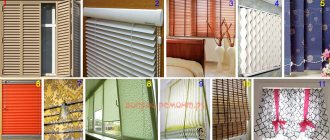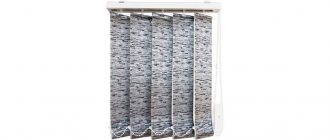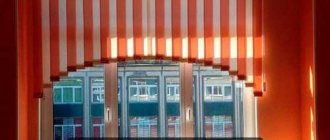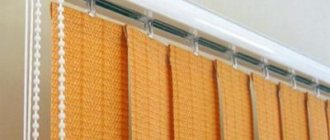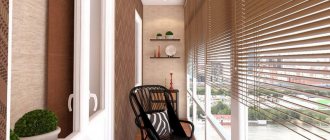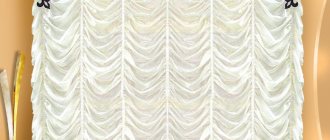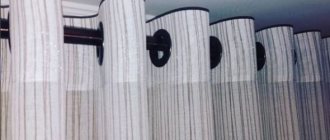/Accessories and decor/Curtains/
If buying new blinds doesn’t fit into your plans or budget, but you have one free evening and a charge of creative inspiration, then we suggest you make your own blinds from available materials.
We have compiled 2 step-by-step master classes on how to make blinds with your own hands and 1 master class on how to update and beautifully decorate horizontal blinds.
Sequence of manufacturing pleated blinds
The main thing in the manufacture of blinds attached to the window sash is to correctly calculate the size of the canvas. In order not only to shade the room from the sun, but also to hide the interior from prying eyes, the pleated panels should be approximately 2 cm wider than the glass on each side. The length of the wallpaper should be one and a half times the height of the window.
Having cut off the required volume of fabric, we proceed to the most important part - folding the accordion. The width of the so-called slats should not exceed 4 cm, otherwise the curtains will not look aesthetically pleasing. Using a pencil on the wrong side, mark the places of future folds.
Using a ruler, make folds.
Using a hole punch, awl or drill, make a hole exactly in the middle of the workpiece.
We stretch a satin ribbon through it and tie a knot on top.
Instead, you can use a silk cord, but the advantage of the tape is that it is easier to match the color of the wallpaper.
At the bottom we insert a drawstring that will adjust the height of the pleated.
Now you need to connect the edges of the bottom fold. This can be done using glue, magnets or double-sided tape. Apply glue without reaching the middle, and then connect both ends, forming a peacock tail. For better adhesion, we put paper clips or simple paper clips on the fold and hold it until the glue dries.
A wooden end cap is used as a weighting material.
We glue double-sided tape over the entire width to the top edge.
We remove the protective layer from the double-sided tape, glue the top fold onto the frame and adjust the height of the curtain, moving the drawstring to the desired level.
Required materials and tools
Most modern designers use these curtains in personal projects and believe that pleated curtains are one of the best window decor options. Pleated blinds will harmoniously fit into any style of home interior; they are universal. Such curtains are made of paper or fabric. Right now we will look at the most affordable and easiest way to create beautiful paper blinds.
For work we prepare:
- A piece of paper. It makes the most sense to use non-woven wallpaper suitable for painting - this material holds pleated folds well and allows light to pass through. You need to calculate the width of the paper based on the width of your window, and it is better to make the length 30-40 cm larger than that of the window.
- Wooden slats 10x10 mm square (2 pcs).
- Sharp blade, awl, hole punch.
- Stationery knife or scissors.
- Pencil.
- Roulette or ruler.
- Glue.
- An end cap (clamp) for a cord or rope, even a large bead will do.
- It is advisable to match the ribbon, decorative rope or cord to match the wallpaper.
- Single-sided and double-sided tape.
Unusual solutions
The following interesting options can be distinguished:
- As mentioned above, wallpaper blinds are more than just a curtain for a window. With their help, you can add liveliness to the interior simply by focusing on them. It can be a bright color, an interesting pattern or texture.
- For especially creative people, the option of coloring the material may be suitable. In this case, you will get a unique drawing. You can use spray paint to create soft color transitions.
- Try experimenting: change the indentation at each fold, making it smaller or larger. Try imagining or sketching to see how it will look overall.
- Avoid inharmonious combinations of colors or their abundance (more than three different ones, not counting the universal black and white). Otherwise, the room will look overloaded and your eyes and brain will get tired quickly. Try not to use too bright colors: over time they become boring and begin to cause irritation. Give preference to pastel shades.
- Remember that patterned blinds are better suited for plain walls, and smooth and plain products for other surfaces.
Sequence of actions performed
The process of creating pleated paper curtains is very simple.
1. Determine the exact height and width of the window.
2. Straighten the roll of wallpaper and apply markings so that the length of the curtain is 30-40 cm longer than the height of the window. Even when unfolded, pleated waves can “eat up” the length of the curtain.
3. The canvas needs to be cut. Don't rush, and take a better length with a small margin; in any case, the excess can be easily cut off. A piece of wallpaper that was ironed on the wrong side.
If it turns out that you have a large window and you don’t have enough wallpaper width, then you can simply glue the canvases together with tape.
4. Place marks on the right and left sides of the paper every 3-5 cm in parallel. You can choose any width of the fold; it mainly depends on the design idea and the dimensions of the window.
5. Using a long ruler, fold in the folds. It is very important to ensure that all folds are the same width and have a clear straight line.
6. The result should be an accordion, with its last fold folded inward.
7. Fold the canvas into an accordion and pierce the paper with a hole punch strictly in the center of the fold. We pass the ribbon or cord through the entire canvas. We cut off the wrong side of the paper and secure the excess ends of the rope with tape.
If your pleated curtain is narrow, then you can control it with just one tape. On the very top fold of your accordion you need to glue a strip of double-sided tape - this will fasten the curtain, and only half-seal the bottom strip with tape.
9. Fold the lower part of the curtain like a fan and glue it with tape. We put a retainer or bead on the ribbon.
10. For a wide curtain, step back 3-5 cm from the edges of the canvas and make two more holes. Thread the adjusting ropes and install the clamps.
11. You need to glue wooden blocks to the top and bottom edges of your curtain. The upper profile will serve as a cornice, and the lower one will hold the shape of the curtain.
You can do without the top bar and simply attach the paper curtain to the window frame with double-sided tape.
Step-by-step master classes
To create high-quality, neat blinds, follow the instructions step by step, take your time, and be especially careful in your measurements.
p, blockquote 34,0,0,0,0 —>
The advantage of homemade curtains is the lack of work with drawings.
p, blockquote 35,0,0,0,0 —>
Each variety has manufacturing features and requires an individual approach. Therefore, decide in advance what kind of curtains you would like to see on the windows.
p, blockquote 36,0,0,0,0 —>
p, blockquote 37,0,0,0,0 —>
Accordion blinds
To make blinds from wallpaper with slats bent like an accordion:
p, blockquote 38,0,0,0,0 —>
- Measure the window in length and width. Add a quarter of the material from the length of the window to the length of your curtains. Otherwise, when folded like an accordion, the curtains will be a quarter shorter.
- Carefully measure the length of the rope according to the length of the curtain.
- Give the piece a pleated look. To do this, measure the strips (it is better if they are from 3 to 5 cm, then the blinds will look elegant and neat.). Make sure that the slats are the same shape. Bend them into an accordion shape.
- If you want to thread the rope along the fabric, use an awl to make a row of holes in the middle of the curtain and insert the lace. You can insert two laces by making holes on the sides.
- Attach the top end of the cord by tying a knot or using tape. If you used two cords, connect them using a clamp, placing a bead at the end or tying a knot.
To make your blinds look three-dimensional, you can increase the width of the slats. This will make the blinds look massive and stylish.
p, blockquote 39,0,0,0,0 —>
Important tips for making pleated curtains
Pleated curtains can also be made from fabric.
For work, you should choose only light material, for example, organza, which contains polyester, silk or viscose. This fabric is rigid and translucent, it has excellent decorative properties and holds its shape well.
Before cutting, the canvas must be processed as follows:
- Soak two sachets of gelatin in a glass of warm water.
- When the gelatin swells a little, heat the resulting solution, but not to a boil.
- We thoroughly blot a piece of your fabric in this solution and hang it to dry. There is no need to unscrew it.
- Once the fabric has dried, it should stand up and crisp.
- After this, the fabric needs to be ironed to make it more elastic and soft.
Next, we proceed in exactly the same way as described above with pleated paper curtains.
When making homemade curtains, be sure to take into account how the curtain will be attached. The choice of fastening elements and the size of the curtain fabric will depend on this.
Method 1 - along the contour of the glass
This fastening method can be chosen only when the depth of the glazing bead in the window is more than 15 mm. This type is most often used when decorating ordinary plastic windows.
Method 2 - on the window frame
The most common type of fastening, because it is suitable for most types of windows. In this case, you can use homemade strips, ready-made brackets, or simply attach the curtain with double-sided tape.
Method 3 - through the window opening
With this type of fastening, it is important to consider the size of the finished curtain. This method is quite suitable only if the distance from the open window sash to the upper slope is at least 6 cm, because the dimensions of the assembled pleated accordion are approximately 5 cm in height.
You can add an unusual decoration to pleated paper blinds with a ready-made sticker or an unusual pattern, this will make the curtain more attractive.
In fact, from all of the above it is clear that making a pleated curtain yourself is not at all difficult, it is fun and simple.
Features of care
Pleated curtains are an unusual design, which means they require appropriate care.
Pleated fabrics cannot be machine washed. The fabric is soaked in warm water, and regular washing powder is used as a detergent.
Washing pleated curtains will help you cope with serious stains.
It is recommended to soak in the folded state, avoiding water getting on the electric drive.
And since the fabric is washed when folded, subsequent ironing is not required. You just need to let the seams dry well, and you can hang the structure on a plastic window. In the case of wooden windows, the curtain must dry completely.
As you can see, pleated curtains are a great way to decorate any window opening functionally and tastefully. And if you make curtains with your own hands, the interior will turn out to be truly exclusive and cozy.
How to make pleated curtains with your own hands
When furnishing her home, every housewife wants to bring something special and stylish to the interior. Something that will not only decorate her home, but will also emphasize her refined taste. Curtains are one of the ways to express your individuality and display a touch of homeliness and beauty in your interior. In this case, pleated curtains will look best on the windows. They can be the highlight of any interior. Do-it-yourself pleated curtains will also become evidence of your skill. And this is not so difficult to do (Fig. 1).
Figure 1. Pleated curtains can be made of paper or fabric, and can also be vertical or horizontal in shape.
Pleated paper curtains
Pleated draperies are made of fabric or paper, and according to the arrangement of the stripes they can be horizontal or vertical. You can choose the material for work yourself.
However, paper curtains are an unusual solution for those who like to frequently change designs and do not want to spend money on expensive fabric.
Figure 2. Scheme of pleated curtains.
In addition to being cheap, paper for curtains has a number of other advantages:
- Style. Nowadays there are a lot of blanks for home interiors with a variety of designs, embossing and appliqués on sale.
- Versatility. You can use paper even without the ability to cut any shapes - vertical or horizontal, fan-shaped or other non-standard curtains.
- Various densities. This allows you to make pleated curtains light for the kitchen, living room and light-proof for the bedroom or nursery.
- Availability. You can even use wallpaper to create pleats with your own hands.
Pleated curtains: manufacturing instructions
In order to make paper curtains, you will need:
- paper the width of the window opening and approximately 1.5-2 times its height (length);
- two wooden planks of the same width;
- glue;
- threads (it is advisable to use thick silk or nylon);
- awl or gypsy needle.
Figure 3. Attaching pleated curtains.
When making pleated curtains at home, follow the instructions:
- We take two wooden planks along the width of the window opening.
- We fold the paper and iron it into small folds the width of the bar.
- Glue the upper edge of the paper web to the strip with glue, press it and let it dry. For fixation, you can use double-sided tape.
- We make even holes along the edge of the paper with an awl or a needle and stretch the threads, securing them to the top bar. If the curtain is too wide, you can stretch the threads every 40-50 cm of the fabric. For high-quality fastening, it is necessary to make holes in the wooden planks, fixing the threads with knots on top and gluing them.
- We calculate the height of the window and the straightened blinds. We cut the paper web according to the required parameters.
- We glue the paper to the bar at the bottom and fasten the threads there.
- Let the structure dry, and the pleated paper curtains are ready (Fig. 2).
Decoration options
To decorate homemade structures, use PVA glue and colored paper, paints, appliqués, stickers, ribbons with tassels, and other decorative elements. They can be glued, threaded, simply secured along the edges or woven into holes inside the canvases. If the wallpaper contains patterns, it will be more difficult to work with it than with plain ones; it would be advisable to make markings with a pencil on the reverse side. In principle, the canvases look attractive and so, you can leave everything as is.
Important! A lot of decor is much worse than no decor at all. Clumsiness should be avoided
Multi-colored blinds are beautiful in themselves, but you can think of additional decor if you wish.
How to attach pleated curtains to a window
There are several types of window curtain mounts. One of the most economical options would be to buy adhesive hooks. Once you have threaded the threads through both pieces of wood, secure the knots and make a loop. We attach the hooks to the window and hang the curtain on them. You can decorate the loops with beads, tassels or other decorative elements.
Another type of fastening can be considered special plastic structures that are attached to the window frame with self-tapping screws. Thanks to the special shape, you can pass the fixing threads through this structure, tightly fixing the paper curtain.
Homemade pleated curtains are a great source of pride for any housewife; by sewing them yourself, you can be proud of your talents and brag about this design solution to your guests (Fig. 3).
Their advantages
Like all roll-up pleated curtains, they have a number of advantages.
- They take up little space and free up the window sill as a work area.
- Pleated curtains are suitable for windows of non-standard shape: triangular, arched, attic windows.
- Easy to care for.
- Variety of fastening types and colors.
- Availability of models that do not allow excess noise and light to pass through.
- Universal to use and suitable for any room.
Pleated curtains
Do you know what pleated curtains are? They are corrugated curtains mounted on a profile. Pleated fabric has different densities, designs, patterns, and textures reminiscent of a fan. Pleated curtains are often used by designers in their ideas, filling window openings with them. They can hang on arched, masandra-shaped or tilted windows of 50 degrees.
The history of the appearance of pleated curtains.
If you translate the word “plisse” from French, then literally it means parallel folds of fabric. It is believed that curtains were invented in ancient Egypt more than a thousand years ago BC. It was the Egyptians who began using pleated fabric to cover their windows. From English “pleated” is translated as Romanesque blinds. They came to Europe in the second half of the last century. More specifically, they found application in Germany. Pleated curtains became widespread at the end of the 20th century; they became an excellent alternative to ordinary roller curtains. Modern pleated blinds consist of the same fabric, special profiles, fasteners and guide strings. The most popular are curtains attached to: – The ceiling. - The wall. - To the window.
In fact, this type of curtain is a universal element for any interior. They perfectly decorate not only windows, but also balconies, massage rooms, loggias, living rooms, winter gardens, and greenhouses. They can also be used for non-standard openings: with slopes, in the shape of an arch, a tricorne, an oval, and imagine - a circle.
Types of pleated curtains.
In the modern market among curtains, blinds, blinds and tulles, pleated occupies a leading position. They can be distinguished by color, material, shape and other features. But still, two main types of pleated curtains can be distinguished: – Paper curtains. Due to the fact that paper quickly loses its appearance and fades, they are hung in bedrooms, living rooms and offices. Pleated blinds can allow sunlight to pass through or be opaque. If desired, such curtains can be made with your own hands. – Fabric curtains. Naturally, they are more durable and very practical. They practically do not fade, are easy to clean and prevent the appearance of dust in the room.

